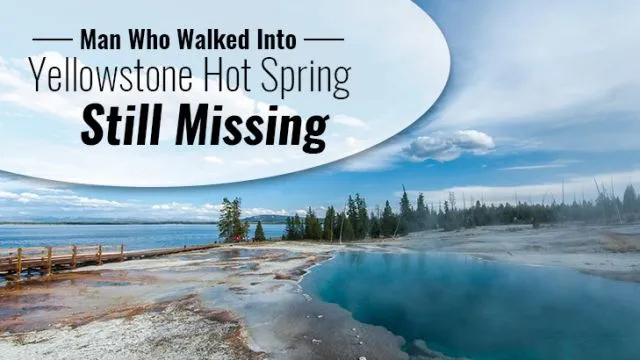
- Share on Facebook61
- Share on Pinterest
- Share on Twitter
Yellowstone National Park in northwestern Wyoming is a vast forest bursting with geothermal activity — thousands of hot springs, mudpots, fumaroles and more than half of the world’s most active geysers — and a playground for outdoor enthusiasts. Yet among the natural wonders lie potential hazards for those who veer off the beaten path.
Park visitors witness man fall into hot springs
A man described as being in his early 20s reportedly walked off the boardwalk and into the thermal spring in the Norris Geyser Basin on Tuesday afternoon. Charissa Reid, a spokesperson for the park, said in a statement to CBS affiliate KRTV that rangers are treating the incident as a probable fatality since the victim has not been located.
The recovery process is extremely difficult, according to Reid, because of the hazards associated with the natural environment. The springs are known to reach temperatures that would potentially kill a human on contact.
Deadly basins
Yellowstone’s basins are among the park’s most deadly spots, injuring and killing more people than any other attraction. Just last week a 13-year old boy was sent to the hospital for burns after he fell into a hot pool in Yellowstone’s upper Geyser Basin. The teen, carried by his father who slipped, burned his foot and ankle.
Norris Geyser Basin, where the man disappeared, is the hottest, oldest and most dynamic of Yellowstone’s thermal areas, according to the park website. Due to frequent disturbances from seismic activity and water fluctuation, the features of the basin can change daily. Also, the vast majority of the waters at the Norris Basin are acidic, including some rare acid geysers.
“The highest temperature yet recorded in any geothermal area in Yellowstone was measured in a scientific drill hole at Norris: 459°F (237°C) just 1,087 feet (326 meters) below the surface! There are very few thermal features at Norris under the boiling point (199°F at this elevation),” the Yellowstone website explains.
Know the rules
As in all national parks, the rules are there to protect hikers. Some adventure-seekers grumble, but the rules exist to prevent deadly accidents from happening. A few weeks ago, for instance, a group of Vancouver-based YouTubers who run the channel High on Life faced criticism and misdemeanor charges after trespassing onto a protected natural site in Yellowstone. The group was caught wandering off the trail and walking onto the famous Grand Prismatic Spring.
In another incident last month, a Canadian man and his son loaded a bison calf into their SUV, claiming they thought it was cold and that the abandoned calf would die without their help.
Unfortunately, the calf was later euthanized because it could not be reunited with its herd. It’s unfortunate that the park chose to euthanize the calf rather than take it to a sanctuary, but it was the human urge to ignore the rules that cost the calf its life.
Have fun but be safe!
If you visit Yellowstone, you should be familiar with the “do’s and don’ts” when it comes to hot springs.
- Boardwalks and trails are there to protect you and to preserve delicate thermal formations. Scalding water sits below most of the thin, breakable crust in thermal areas. Pools below may be near or above the boiling point of water and can cause severe or fatal burns.
- Always stay on boardwalks and trails when visiting thermal areas. Keep your children close and educate them about the danger posed by boiling water.
- Pets are not allowed in the thermal areas.
- Swimming or bathing in thermal pools or streams, where water flows completely from a thermal spring or pool, is not allowed.
While there are areas where swimming is permitted, be aware that thermal waters contain organisms known to cause infection or worse, amebic encephalitis, a rare disease that the Centers for Disease Control and Prevention (CDC) says is almost always fatal. Between 1962 to 2015, there have been 138 reported infections in the United States, with only three survivors. In addition, the park warns of toxic gases, which can exist at dangerous levels in some of the hydrothermal areas. If you feel sick, leave the area immediately.
Meanwhile, the Norris Geyser Basin remains closed as park officials continue to look for the missing man. For more information on safety around thermal features, visit the National Park Safety Page.
—Katherine Marko
- Share on Facebook61
- Share on Pinterest
- Share on Twitter

